The Economics and Statistics Division maintains archives of previous publications for accountability purposes, but makes no updates to keep these documents current with the latest data revisions from Statistics Canada. As a result, information in older documents may not be accurate. Please exercise caution when referring to older documents. For the latest information and historical data, please contact the individual listed to the right.
<--- Return to Archive
For additional information relating to this article, please contact:
November 06, 2019POPULATION OF CENSUS FAMILIES FOR JULY 1, 2019 Statistics Canada has released revised estimates of the number of census families as of July 1, 2019.
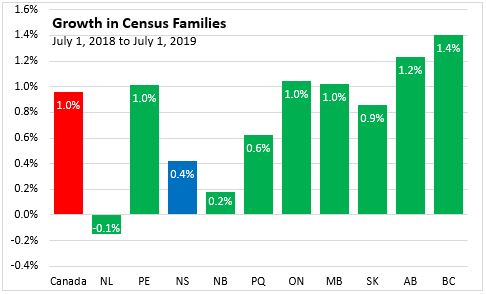
The number of census families in Nova Scotia increased by 0.4 per cent from July 1, 2018 to July 1, 2019, reaching 278,475 families. Across Canada, census family growth has followed stable trends. There is faster growth in Ontario and western provinces as well as in Prince Edward Island. Census family growth is slower in Quebec, Nova Scotia and New Brunswick while the number of census families declined in Newfoundland and Labrador.
In most provinces, growth in lone parent families is outpacing growth in couple census families. Couple economic family growth is faster than lone parent family growth only in Prince Edward Island, New Brunswick and British Columbia.
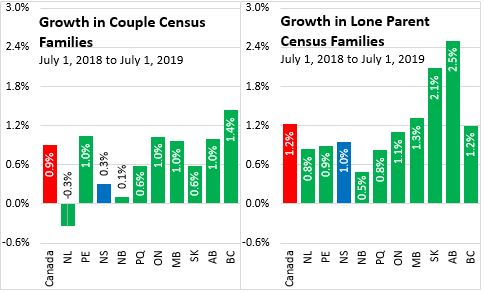
Of the 278,475 census families in Nova Scotia there were 227,609 couples census families and 50,866 lone parent families. Nova Scotia has the second highest share of lone parents among census families (18.3 per cent) after Saskatchewan (18.8 per cent). British Columbia (15.0 per cent) and Alberta (15.3 per cent) have the lowest portion of lone parents among census families.
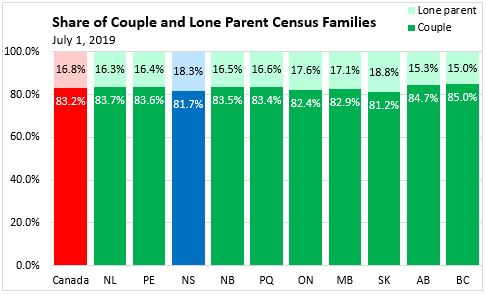
Nova Scotia used to have the hightest portion of lone parents among census families, but in the last three years, there has been a notable rise in the share of lone parents among Saskatchewan census families. Although the share remains lower, there has also been a notable rise in the share of lone parents among census families in Ontario. The share of lone parents among census families has been declining in British Columbia. After some years of decline, there has been a rising share of lone parents among census families in Newfoundland and Labrador, New Brunswick and Alberta.

In every year from 2006 to 2014, growth in census families in Nova Scotia was the slowest or second slowest among provinces. From 2016 onwards, there has been faster growth in the number of census families in Nova Scotia, catching up average growth with New Brunswick and Newfoundland and Labrador. However, long run growth in Nova Scotia census families lags Prince Edward Island as well as the large urban provinces (Ontario, Quebec, British Columbia) and the three prairie provinces.
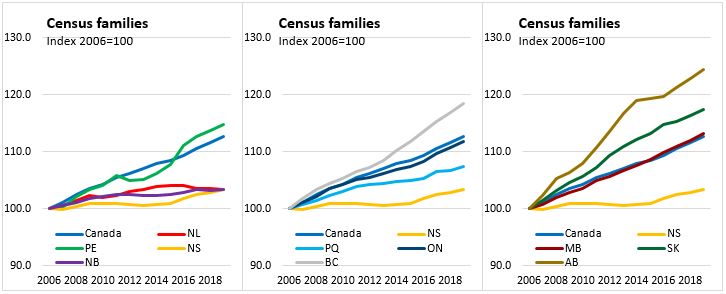
Nova Scotia continues to exhibit slower growth in the number of couple families compared with all other provinces, but the pace of growth has accelerated since 2015.
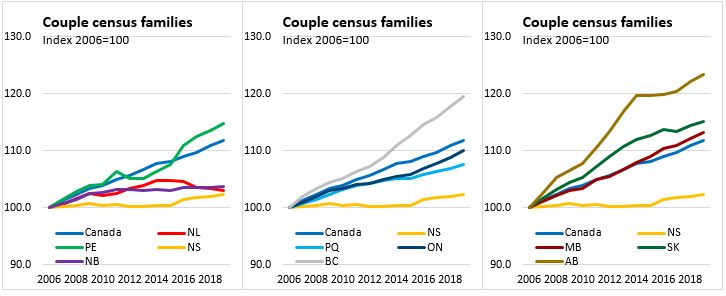
Nova Scotia has had faster growth in the number of lone parent families than in New Brunswick or Newfoundland and Labrador. The number of lone parent families in Nova Scotia has been rising at a similar pace to that observed in Quebec.

Notes: Statistics Canada defines a census family as a married couple (with or without children of either and/or both spouses), a common-law couple (with or without children of either and/or both partners) or a lone parent of any marital status, with at least one child. A couple may be of opposite sex or same sex. Note that this definition excludes unattached individuals and thus is not equal to the number of households.
Source: Statistics Canada. Table 17-10-0061-01 Estimates of the number of census families as of July 1st
<--- Return to Archive